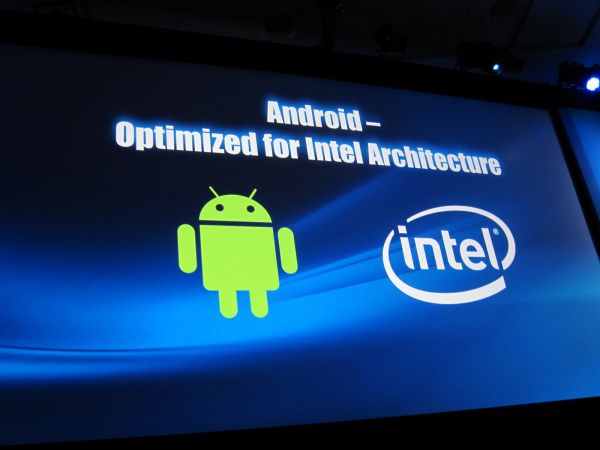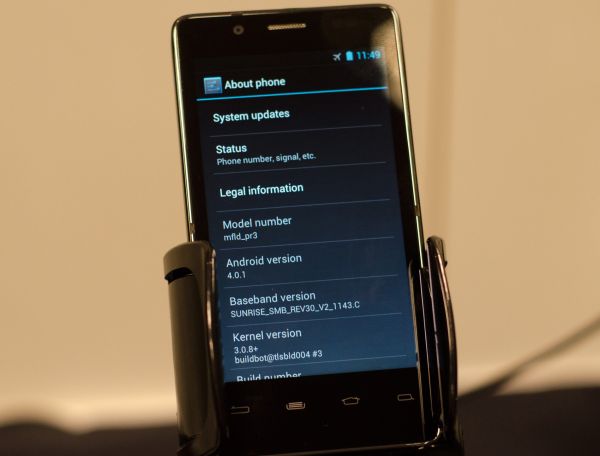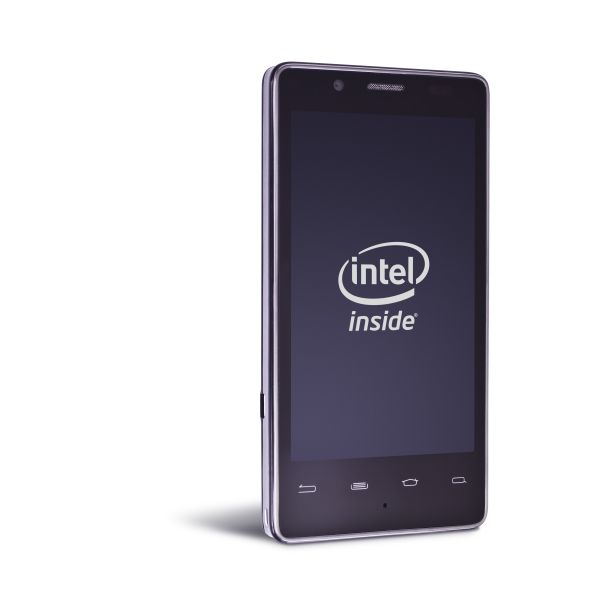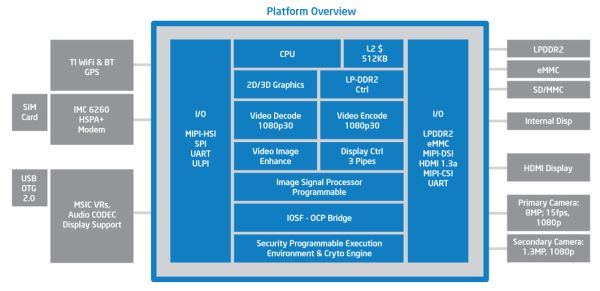Intel's Medfield & Atom Z2460 Arrive for Smartphones: It's Finally Here
by Anand Lal Shimpi on January 10, 2012 8:00 PM ESTWhat's Different This Time Around: Google & A Sweet Reference Platform
Intel has been talking about getting into smartphones for a couple of years now, but thus far it hasn't been able to secure a single design or partnership that that resulted in a product actually coming to market. This time around, things are different. The major change? Focus, and Google.
Intel originally had ambitions of enabling its own mobile OS with the help of Nokia (Moblin/MeeGo). Intel also wanted to support Android as well, however its attention was clearly more focused on the Moblin/MeeGo effort. Similar to the wake up call that pushed NVIDIA to focus exclusively on Android, Intel has now done the same.
At IDF last year Intel and Google announced a partnership and the intention to bring all future versions of Android, starting with Gingerbread, to x86. Since then Intel has ramped up the software engineering engine, going into the Android source code (Gingerbread, Honeycomb and now ICS) and fixing bugs. Intel's goal is to deliver the most stable version of Android as a result of its efforts. Intel is also submitting its changes upstream to the AOSP, which should help improve the Android experience even on ARM platforms.
Under the leadership of Mike Bell (formerly of Apple and Palm), Intel has also created an extremely polished Medfield reference design. This is the same design shown off at IDF last year (apparently there's an even thinner one floating around somewhere), but what separates it from other reference designs we've seen from SoC vendors is that the Medfield reference platform was designed to be a polished phone that could theoretically be rebranded and resold.
Intel knew the onus was on itself to prove that Medfield, Atom and even just x86 was power efficient enough to be delivered in a compelling form factor with competitive battery life. Paul Otellini gave Mike carte blanche access to any of Intel's resources. Instead of having to work with existing Intel groups, Mike was allowed to assemble his dream team of engineers. The team Mike built is what he felt he needed to not only bring Medfield to market, but also to build the a first class Atom based smartphone.
The result is this:
Internally it features Intel's own XMM 6260 HSPA+ modem. Intel claims LTE is on the way although there's no ETA on that.
WiFi in the reference design is provided by TI's 1283 controller. Intel's wireless team does not have a a WiFi solution that's low power enough to work in a smartphone, although after the recent restructuring the team has now been tasked with building an ultra low power solution that can.
The display is a somewhat unusual 1024 x 600 panel, with support for 1080p30 (and 1080i60) output via HDMI. The SoC specs are identical to what I've already discussed: 1.6GHz max CPU clock and a 400MHz GPU clock.
The reference platform is not only smartphone sized, but Intel has built its own qualification labs that mirror those of the carriers to ensure quality and convince its customers of the platform's legitimacy. In essence, Intel has built its own miniature smartphone design and test center.
The Medfield reference platform is available for use by any of Intel's customers, and indeed that's what's already happening. Lenovo's K800 is based on a modified version of Intel's reference platform, and I wouldn't be surprised if more aren't on the way.
All of this sounds a lot like Intel's efforts in the motherboard space over a decade ago where it started providing motherboard manufacturers with reference designs that they could modify if they desired. The effort helped significantly reduce time to market and allowed the motherboard makers to focus more on specializing on what they were good at.
The Medfield reference platform is designed to do the very same for smartphones. Intel wants to provide its partners with a well designed, stable smartphone platform. If they choose to use it, they can shave off a significant amount of development time and spend more of their time on software or simply bring a good reference phone to market in a quick fashion. I'm not entirely sure I've seen many players in the Android space that are actually all that great at software development, but Intel believes anything that shortens time to market will be appreciated.
I asked Intel if it has any plans to offer the reference platform unlocked, direct to customers. Unfortunately the answer at this point is still no. I suspect that Intel is more interested in building its customer base rather than circumventing it.
















164 Comments
View All Comments
Hector2 - Wednesday, January 11, 2012 - link
So you doubt Anand's power measurements too ?As for the DX11 demo, Intel's VP showed very poor judgement running a video when they had trouble getting the demo out in time -- that's a major screw up, but Anand showed that the hardware actually works in spite of the screwed up demo.
french toast - Thursday, January 12, 2012 - link
No i dont doubt Anands Integrity or his benchmarks, i have just questioned his optimistic assuptions on un proven Intel hardware, especially when Intel produced the scope and the power benchmarks.All of which compare last years hardware, all the Intel sorced benches are single threaded and are likely due to Intel software optimisations, and lastly because the atom is higher clocked.
The benches as exophase has pointed out are on things that the cpu is not loaded/stressed.
Its great he has provided us with an insight, but this in no way proves that this architecture is the best nor does it prove that it would have 'dominated' android devices last year for a whole number of reasons that i cant be bothered to re-type.
Anand has jumped the gun on his conclusions thats all im saying
Dark_Archonis - Tuesday, January 10, 2012 - link
Time for the haters to eat their words, and the ARM supporters to admit they were wrong.On the forums there were enough self-proclaimed "experts" that claimed Intel was doomed and that ARM would take over. Well who's laughing now? Here we see an Atom SoC, that has power characteristics EQUAL or BETTER THAN ARM SoCs, while posting very strong performance as well. This is keeping in mind that it is just the first step for Intel in the smartphone market.
ARM supporters are already claiming that Medfield only looks good because it's being compared to year-old ARM designs. But guess what, the Atom design is 5 years old! Yes, this is a new SoC for Intel, but the fact is Intel must be given HUGE credit that they were able to make an SoC based on the 5-year old Atom design that is extremely competitive in power and performance to ARM SoCs.
Next-gen ARM designs will arrive later this year yes, but Intel will not stand still either. Also lets not forget about the next-gen Atom that will come in 2013 on the 22nm process. That will be a HUGE leap forward for Intel and will put them in an extremely competitive position against any quad-core ARM SoCs.
DigitalFreak - Tuesday, January 10, 2012 - link
You want a cookie or something? No-one cares about your fanboy rant.Dark_Archonis - Tuesday, January 10, 2012 - link
Obviously you cared enough to login, and make a useless, childish post devoid of anything meaningful, instead of actually replying to what I had posted.Great job at proving yourself wrong.
name99 - Wednesday, January 11, 2012 - link
Dude, the reason he is (justifiably) mocking you is that you are comparing ARM silicon that is shipping TODAY with Intel silicon that will be shipping in a YEAR.That's how it works among adults --- you compare shipping with shipping, not what I plan to ship (one day) with what you plan to ship (one day).
guilmon19 - Tuesday, January 10, 2012 - link
Except that Medfield is built on a 32nm process while ALL available A9s out there are built on the 45nm process. If the A9's were 32nm as well these benchmarks would be very different and these benchmarks came straight from intel, lets way wait till we actually get the phone and do benchmarks from there to determine which one is better.madmilk - Tuesday, January 10, 2012 - link
Doesn't matter than Medfield is 32nm, by the time anyone else makes a 32nm SoC Intel will be on 22nm.It's a massive advantage that can't just be thrown away, especially if trying to make a fair comparison.
Exophase - Tuesday, January 10, 2012 - link
Hardly, TSMC 28nm ARM processors are right around the corner while 22nm Atoms won't hit until 2013. Intel's doesn't yet have the same process advantage with their LP SoC nodes.Dark_Archonis - Tuesday, January 10, 2012 - link
Your point being? Even looking at TSMC's 28nm process, Intel will still have quite an advantage with their 22nm process. ARM will only have an advantage for a few quarters with the 28nm process, then Intel will come out with their 22nm process. You also fail to acknowledge that Atom on 22nm (Silvermont) will a brand new Atom architecture, which you can bet will be a HUGE leap forward in performance and power efficiency.TSMC is well known for having lots of trouble moving to new a process. Exophase, you should rephrase "right around the corner" to say in 1-2 quarters at the very least. It will still be a few months before we see any 28nm ARM phones actually on the market.
Intel has aligned their mobile and desktop process roadmaps, so all future Atoms will move to a new process node as fast as Intel's desktop chips.
Intel will also have a technological advantage as their 22nm process introduces FinFET, while TSMC won't have FinFET until their 14nm process.
Furthermore, Intel intends to introduce 14nm in 2013/2014, while TSMC won't introduce 14nm until 2015.
Intel was really slow getting into the smartphone market, but now that they have their foot in the door, they will not let off the gas. Intel's efforts in the smartphone market will only accelerate from this point. Intel will attack ARM directly at the low-end power scale in this case, and ARM will struggle greatly at the high end as Intel's Haswell will offer revolutionary power/performance ratios. That's not even mentioning what power/performance ratios we will see from the the next-gen Atom design.
Also let me restate that this is Intel's *first step* into the smartphone market, and they are able to be very competitive with ARM designs.